The Frog Pond on Boston Common - Birth of Boston's Public Water System
Introduction
Text-to-speech Audio
In a ceremony that drew 100,000 people, Boston’s public water system was born in 1848 as water flowed into the Frog Pond on Boston Common.(4) Yet, deadly Typhoid outbreaks(3) in 1849 and 1866 and the Great Fire of 1872 would demonstrate that Boston’s water supply was neither safe nor sufficient. Ellen Swallow Richards (1873 S.B. Chemistry) would be at the forefront of the 19th-century Sanitary Revolution that would improve public health, child survival, and life expectancy. She also led the way to new fields within science, engineering, and medicine: ecology, toxicology, epidemiology, environmental engineering, and planetary health.
According to the 1875 President’s Report, MIT’s Chemistry laboratories were located in the basement of the Boylston Street Rogers Building. From 1876-1883, Ellen would also have worked, alongside her students, at the Woman’s Laboratory in the MIT Annex. However, by 1884, Ellen would be assigned a dedicated laboratory space on the third floor of the new Walker Building for her work in Sanitary Chemistry.
Images
"View of the water celebration, on Boston Common October 25th. 1848." Lithograph by P. Hyman and David Bigelow.
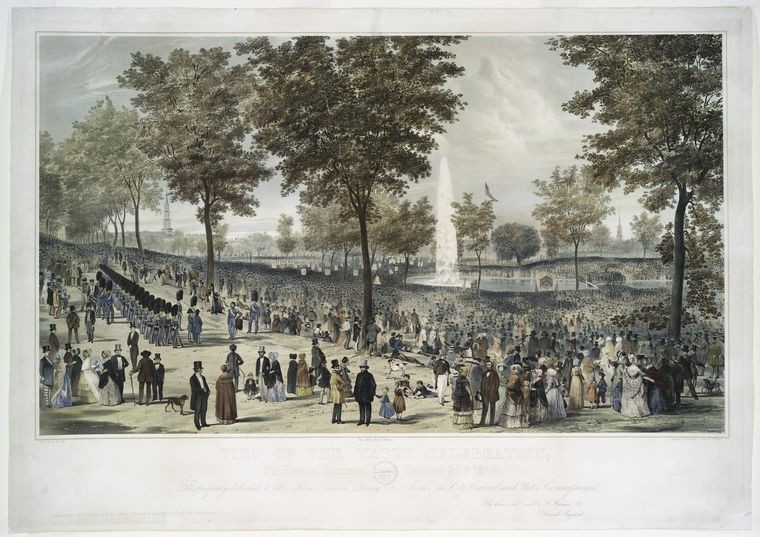
Great Boston Fire of 1872
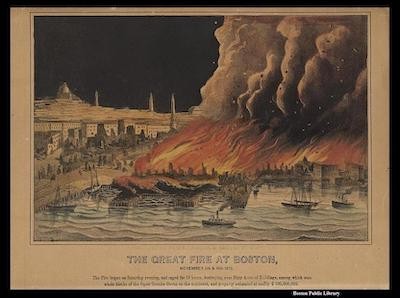
Ellen Henrietta (Swallow) Richards sampling water, circa 1872
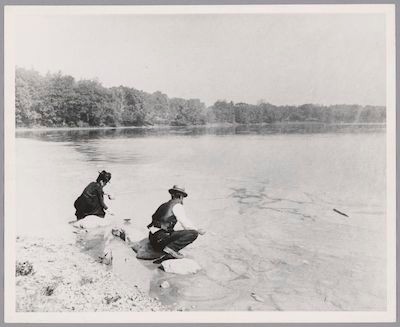
Ellen Richards' Water Quality Laboratory
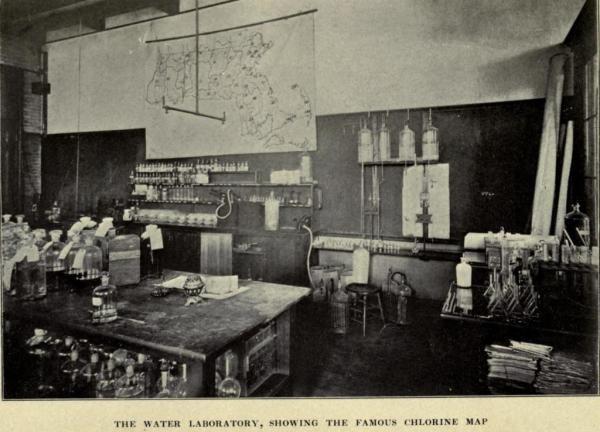
State Board of Health map of the State of Massachusetts showing normal chlorine (color reproduction), 1890 - 1890
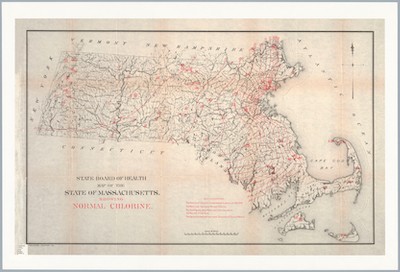
Ellen Swallow Richards works at a desk.
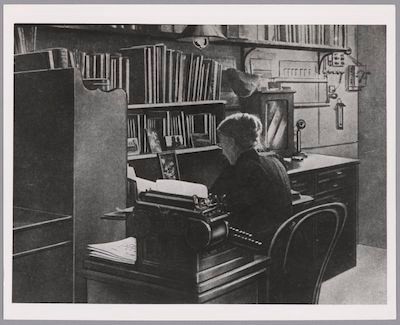
Backstory and Context
Text-to-speech Audio
Between 1800 and 1900, Boston’s population grew from about 24,000 inhabitants, mostly of English ancestry, swelling to over 500,000 people with a diverse and teaming population of Irish, Italian, Jewish, and other immigrants.(16) As Boston’s population exploded, sanitary conditions deteriorated, and infectious disease outbreaks became more common. In April 1872, the Massachusetts Board of Health hired MIT Professor William Ripley Nichols to investigate water pollution caused by industrial waste and municipal sewage discharge. Although Professor Nichols had been among the MIT Faculty most opposed to Ellen’s admission, he soon recognized Ellen’s exceptional analytical skills and recruited her to assist in his investigation. In a letter to a friend, dated August 14, 1872, Ellen shared: “Now a new work has been put into my hands which will tell, and that by a Professor who does not believe in women's education.”(7) Three months later, she adds, “The record since I wrote might almost be summed up in one word ‘Work.’ I have made about 100 water analyses and that is only part of my daily duties. I have been studying with the classes since October 9th. I have to prepare my lessons evenings.”(7)
Work on the Massachusetts Board of Health Water Study was well underway by November 1872 when a disastrous fire ravaged Boston, destroying 65 acres, including the Mercantile Building on Summer Street, where MIT first held classes. Ellen witnessed the fire’s destruction and aftermath. "It was a strange feeling to stand out in the still night and see so intense and angry a monster eating up our stone walls."(7) After the Great Fire, Boston revamped its water distribution system to increase pipe size and hydrant flows. Water volume improved, but Ellen’s training of students like George C. Whipple, who would set up the first municipal water lab at Chestnut Hill, would be one of many water quality experts needed to improve the drinking water quality.
Professor Ripley acknowledged Ellen’s contributions to the Fourth (1872)(12) and Fifth Annual reports (1873)(11) of the Massachusetts Board of Health: “Most of the analytical work has been performed by Miss Ellen H. Swallow [...] I take pleasure in acknowledging my indebtedness to her valuable assistance, and in expressing my confidence in the accuracy of the results obtained.”(11) By 1873, Ellen would be a nationally recognized expert in Water Analysis and Industrial Chemistry. After completing her degrees, although Ellen worked at MIT without pay, she earned a small income through private commissions and lecture fees. With support from the Woman's Education Association (WEA), Ellen established the MIT Woman's Laboratory in 1876. This Laboratory enabled women, especially secondary school teachers, to gain greater competence in scientific laboratory techniques. In 1883 the Woman’s Laboratory closed to make way for the Walker Building. Within six months, MIT hired Ellen as an Instructor in Sanitary Chemistry with a dedicated laboratory on the third floor of the new Walker building. Considered an elective for 3rd or 4th-year students, Ellen's class covered Chemistry, Bacteriology, and Engineering concepts, educating the men who would design and operate the world's first modern municipal sanitation facilities and research stations and establish public health, water testing labs, and sanitary engineering departments.(2,14)
From 1887-1897, Ellen served as an official water analyst for the Massachusetts State Board of Health. Ellen’s former students also helped. Lilly Miller Kendall (1892 S.B. Chemistry) worked with Ellen and Professor Drown from 1892-99, and Amy Maria Stantial Land (1884 S.B. Chemistry) assisted Professor Nichols from 1884-86.(1) The 1887-1890 Mass Board of Health Studies by Ellen and Professor Thomas Drown analyzed 40,000 water and wastewater samples from 83% of the state population, leading to the development of the Normal Chlorine Map, the first water quality map, which became the standard for future sanitary surveys. According to the Chemical Heritage Foundation, “The scale of the survey was unprecedented: it led to the first state water-quality standards in the nation and the first modern municipal sewage treatment plant in Lowell, Massachusetts.”(4) Ellen continued as a Sanitary Chemistry instructor at MIT until she died in 1911. She authored more than 15 books, numerous articles, and reports in environmental science and engineering.(5,15)
Ellen Richards was a master at navigating the waters of gender bias. Yet she, the “Great Teacher,” wrote in 1889: “I have helped five men to positions they would not have held without me, but I am content.”(8) Ellen may have been referring to the “fathers” of America’s Sanitary Revolution. William R. Nichols (Ellen’s junior), who was an MIT chemistry professor and author of the 4th & 5th Massachusetts State Board of Health Reports for which she performed the water analyses; William T. Sedgewick and George C. Whipple, two of the three founders of the Harvard-MIT School for Health Officers (1913), which became the Harvard School of Public Health (1922), the first school of public health in the U.S.; Thomas Drown, who, in 1885, was appointed director by the Massachusetts Board of Health to the new Lawrence Experimental Station which undertook groundbreaking engineering research that led to the 20th-century water and wastewater treatment designs; and Allen Hazen, President of the New England Water Works Association and Vice President of the American Society of Civil Engineers, who together with George C. Whipple formed an engineering company that went on to build that modern water/sanitation infrastructure in numerous cities in Massachusetts and across the U.S. Ellen’s Sanitary Revolution foundational work made their work possible. Indeed, there were hundreds if not thousands of women and men, ourselves included, whose positions, indeed, whose health and well-being, would not have been realized without Ellen’s selfless efforts.
Sources
- Bever, Marilynn Arsey, The women of M.I.T., 1871-1941: who they were, what they achieved. 1976, Massachusetts Institute of Technology, SB Department of Humanities thesis. DSpace @ MIT. http://hdl.handle.net/1721.1/33804. Accessed 27 Jan 2023.
- “Course Catalogue of the Massachusetts Institute of Technology 1884 - 1885.” Dome Home, 1884. https://dome.mit.edu/handle/1721.3/82726. Accessed 17 Jan.2023.
- “Early Sanitation in Boston | Histories of the Calf Pasture Pumping Station.” UMass Boston Sites Network, 13 Apr. 2013. https://blogs.umb.edu/pumpingstation/category/early-sanitation-in-boston/. Accessed 15 Jan. 2023.
- “Ellen H. Swallow Richards | Science History Institute.” Science History Institute, 1 June 2016, https://www.sciencehistory.org/historical-profile/ellen-h-swallow-richards. Accessed 18 Jan. 2023.
- “Ellen H. Swallow Richards - American Chemical Society.” American Chemical Society, https://www.acs.org/education/whatischemistry/women-scientists/ellen-h-swallow-richards.html Accessed 19 Jan. 2023.
- “Great Boston Fire of 1872 - Boston Fire Historical Society.” Boston Fire Historical Society, https://bostonfirehistory.org/fires/great-boston-fire-of-1872/. Accessed 17 Jan. 2023.
- Hunt, Caroline Louisa, 1865-1927. The Life of Ellen H. Richards, 1842-1911. Anniversary ed. Washington: American Home Economics Association, 1958. Via HathiTrust.org. https://hdl.handle.net/2027/uc1.b3888672. Accessed 19 Jan. 2023. (pg 56)
- Letter to “Nettie” (Mrs. Robert Barnard), March 1889, quoted in “Recollections of Ellen H. Richards,” Journal of Home Economics, Volume 23 (December 1931). http://reader.library.cornell.edu/docviewer/digital?id=hearth4732504_23_012#page/31/mode/1up. Accessed 24 May 2023. (pg 1125)
- “MWRA - Water System History.” MWRA - Home, https://www.mwra.com/04water/html/hist1.htm. Accessed 15 Jan. 2023.
- Murcott, Susan. Ellen Swallow Richards: Public Health and the Chestnut Hill Biological Laboratory. 26 Jul. 2018, Lecture at Metropolitan Waterworks Museum. PowerPoint Presentation. https://www.dropbox.com/s/sqi3s5fex47ml80/EllenSwallowRichards_Public%20Health_WaterWorks%20Museum_FINAL_7-26-18.pdf?dl=0. Accessed 24 May 2023.
- Nichols, William Ripley. “Fifth Annual Report of the State Board of Health of Massachusetts (1873).” DSpace Home, Massachusetts State Board of Health, Jan. 1874, https://archives.lib.state.ma.us/handle/2452/782616. Accessed 17 Jan. 2023. (pg 64)
- Nichols, William Ripley, and George Derby. “Fourth Annual Report of the State Board of Health of Massachusetts (1872).” DSpace Home, Massachusetts State Board of Health, Jan. 1873, https://archives.lib.state.ma.us/handle/2452/782615. Accessed 18 Jan. 2023. (pg 108)
- President’s Report 1875. https://libraries.mit.edu/archives/mithistory/presidents-reports/1875.pdf#page=253. Accessed 17 Jan. 2023.
- President’s Report 1884. https://libraries.mit.edu/archives/mithistory/presidents-reports/1884.pdf#page=20. Accessed 18 Jan. 2023.
- “Publications by and about Ellen Swallow Richards.” Archive-It Wayback Machine, Institute Archives & Special Collections: MIT, Aug. 1999, https://wayback.archive-it.org/7963/20190702120221/https://libraries.mit.edu/archives/exhibits/esr/esr-bibliography.html.
- “The Contemporary City.” Encyclopædia Britannica, Encyclopædia Britannica, 19 May 2023, https://www.britannica.com/place/Boston/The-contemporary-city.
- Vesilind, P. Aarne, and Susan Murcott. “Ellen Swallow Richards: The First Woman Environmental Engineer.” Environmental Engineer, no. Volume 32, Number 4, American Academy of Environmental Engineers, Oct. 1996, pp. 13–18.
- “Water for the City: A Short History of Boston’s Water Supply System – Local Historian North & South.” Local Historian North & South, https://www.facebook.com/WordPresscom, 24 Sept. 2017, https://wpmarchione.com/2017/09/24/water-for-the-city-a-short-history-of-bostons-water-supply-system/. Accessed 24 May 2023.
1. Lithograph. The New York Public Library Digital Collections. 1849. https://digitalcollections.nypl.org/items/510d47d9-7ca4-a3d9-e040-e00a18064a99. Accessed 24 May 2023.
Fire: Courtesy of the Boston Public Library.https://bostonfirehistory.org/fires/great-boston-fire-of-1872/. Accessed 10 Mar. 2023.
Courtesy of the MIT Museum. https://mitmuseum.mit.edu/collections/object/GCP-00024199. Accessed 15 Jan. 2023.
Lab. From The Life of Ellen H. Richards, by Caroline L. Hunt. Published 1912. https://hdl.handle.net/2027/uc2.ark:/13960/t3513ww21?urlappend=%3Bseq=141. Accessed 24 May 2023.
Courtesy of the MIT Libraries Distinctive Collections
Ellen at Desk. Courtesy of the MIT Museum. https://mitmuseum.mit.edu/collections/object/GCP-00024202. Accessed 15 Jan. 2023.
